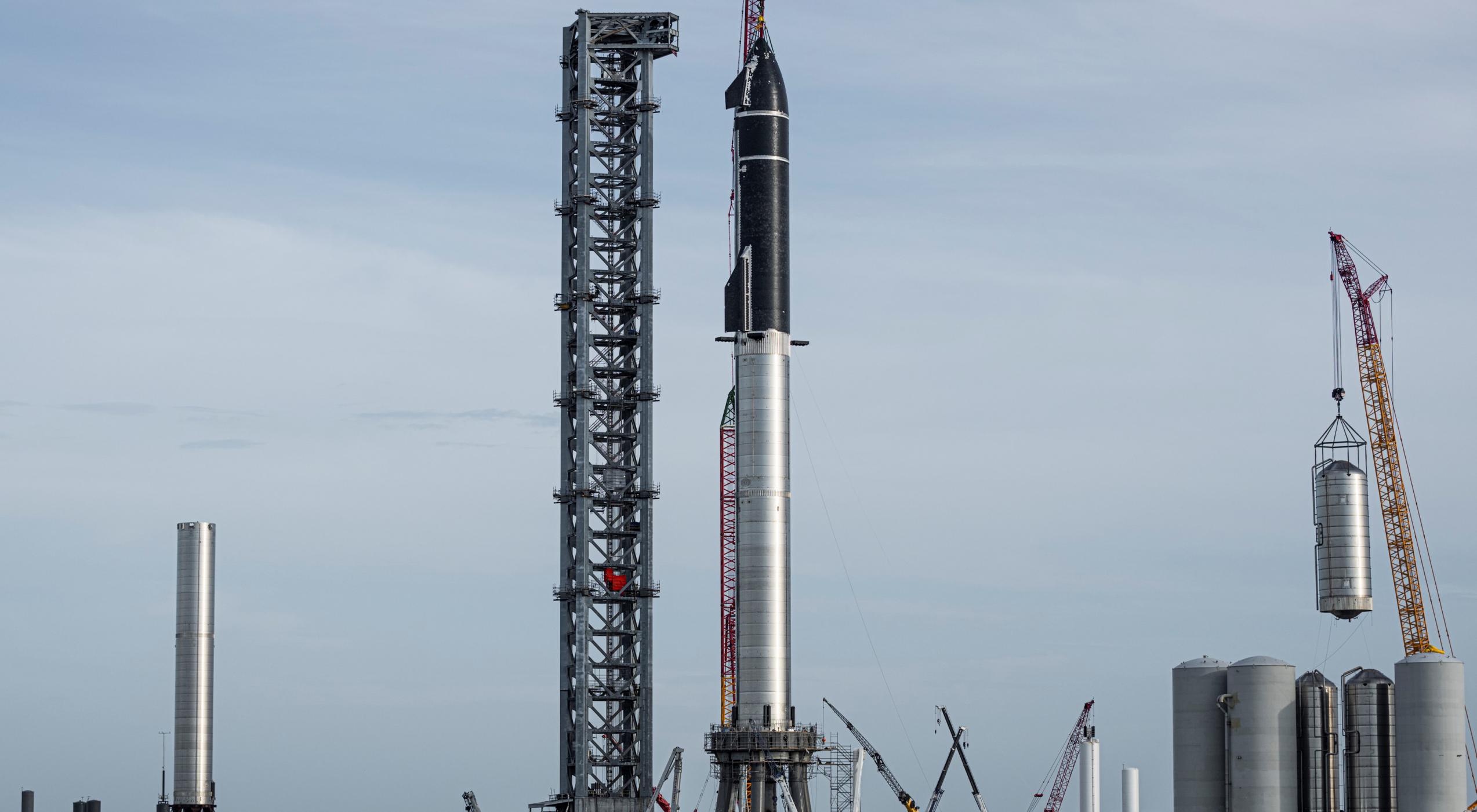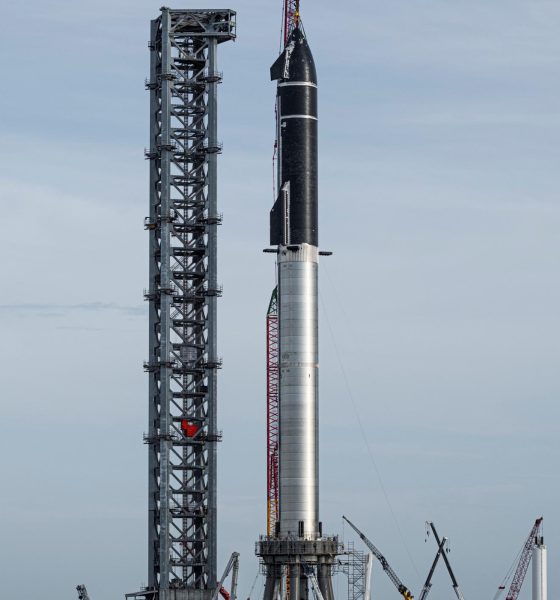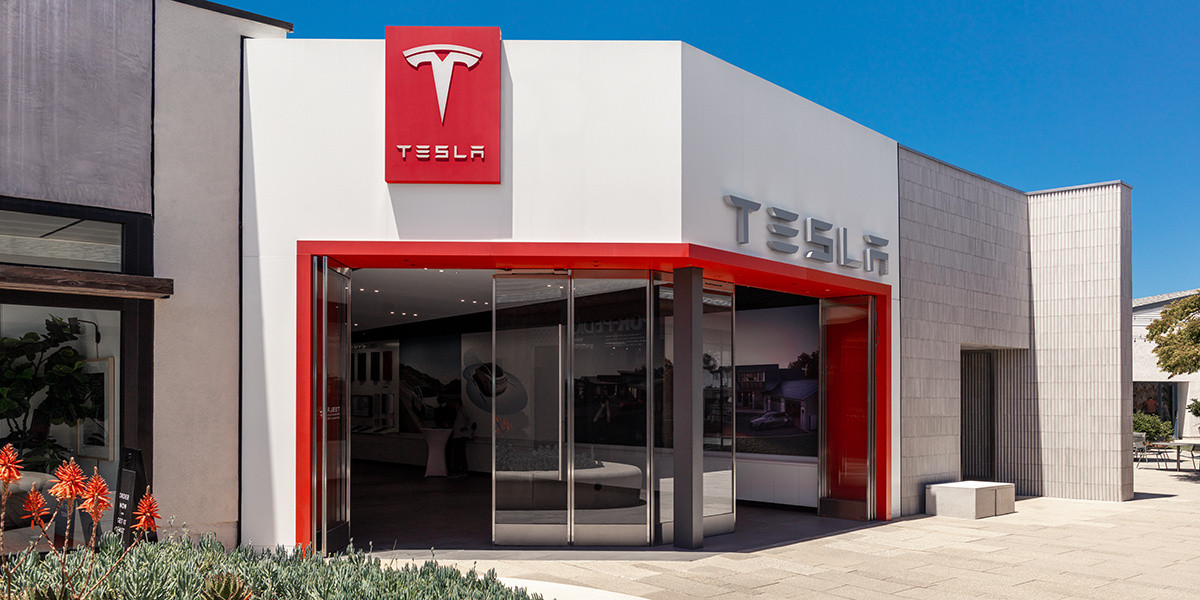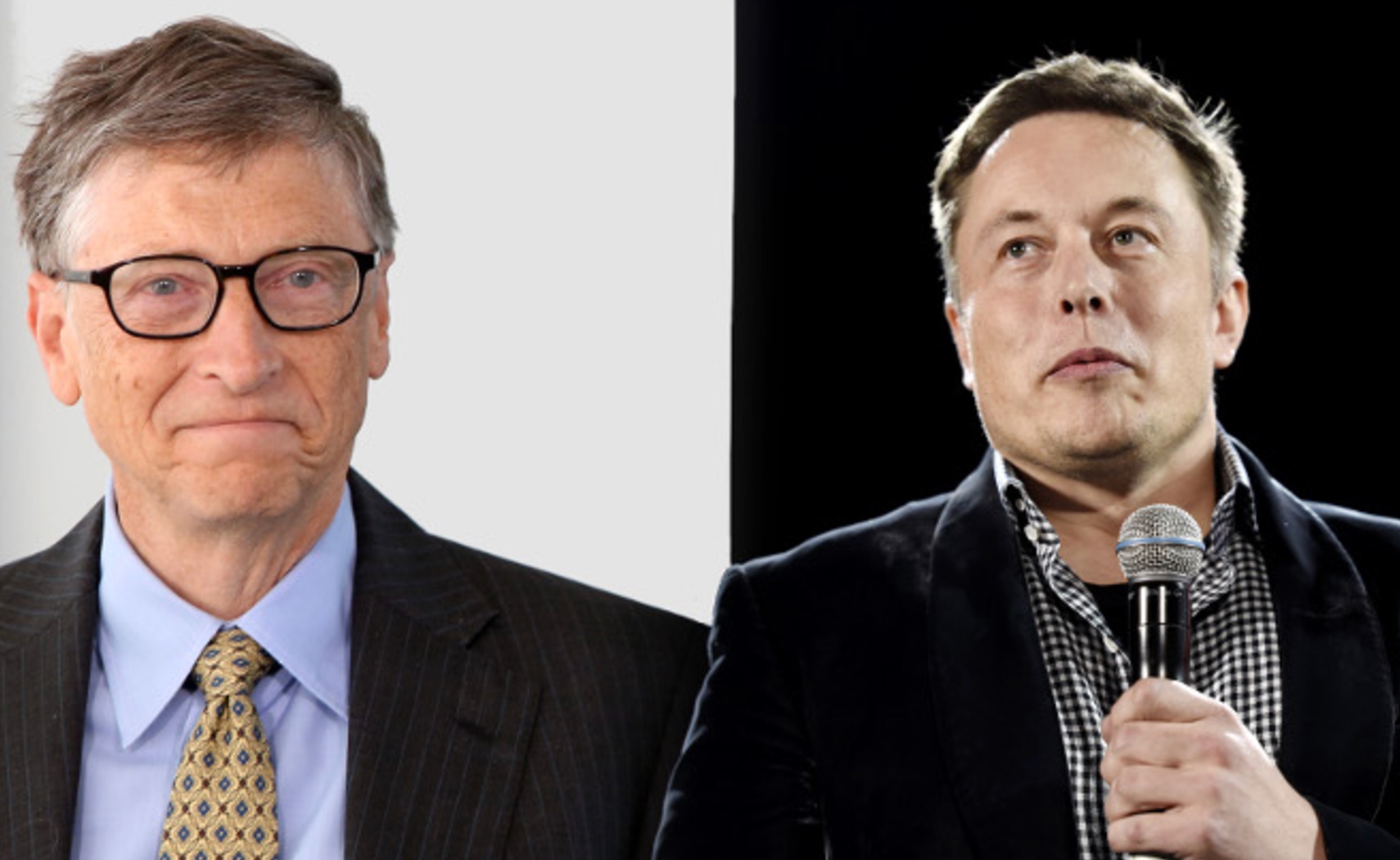

News
Elon Musk says SpaceX’s orbital Starship debut headed for FAA faceoff in a few weeks
CEO Elon Musk says that SpaceX’s first completed Starship rocket could be ready for its orbital launch debut just “a few weeks” from now – far sooner than most expected.
On August 6th, SpaceX very stacked that same vehicle – Starship 20 (S20) and Super Heavy Booster 4 (B4) – to its full height for the first time ever, briefly creating the largest rocket ever assembled. However, the feat was equally a symbolic photo opportunity. SpaceX did install an unprecedented number of Raptor engines on Booster 4 and Ship 20 in a spectacularly short timeframe and both stages are technically meant for flight, but Starship S20 was demated less than an hour later and shipped back to the factory shortly thereafter.
Though they’d had Raptors installed and been stacked to their full ~120m (~390 ft) height, neither booster or ship were truly complete and at least 20% of their engines had yet to be qualified at SpaceX’s McGregor, Texas test campus. Both needed a week or two of additional work – mostly just wiring avionics and installing secondary and tertiary plumbing. Curiously, on August 13th, Starship S20 was once again rolled to SpaceX’s Boca Chica launch site in a partial state of completion, where it now sits beside the orbital launch mount for unknown reasons.
After several days of delays, SpaceX also removed Super Heavy B4 from the orbital launch mount and returned it to the build site on August 11th, where teams are still working to finish its secondary plumbing and avionics. Like Ship 20, all of its Raptors were removed soon after its return, freeing both to complete cryogenic proof testing without risking dozens of potentially flightworthy rocket engines.
Like all previous Starship prototypes, those ‘cryo proof’ tests will involved loading Ship 20 and Booster 4 with supercool liquid nitrogen (LN2), simulating the weight and extreme thermal stress of real liquid oxygen (LOx) and methane (LCH4) propellant without the risk of a catastrophic fire or explosion in the event of anomalies.
For more than a month, SpaceX also gradually outfitted one of two suborbital launch mounts with special hydraulic rams that would have simulated the thrust of Ship 20’s three sea level and three vacuum-optimized Raptor engines – the first Starship prototype with such a configuration. The same was true for Booster 4 and SpaceX had outfitted a new test jig with nine hydraulic rams labeled “B4” – clearly meant to simulate the thrust of nine engines pushing against the Super Heavy’s thrust puck. Additionally, a far larger structural test tool unofficially nicknamed the ‘can crusher’ has been more or less finished after ~6 weeks of work, leading many to assume that Booster 4 would be the first Super Heavy to be subjected to the immense simulated thrust of 29 Raptor engines.
However, earlier this week, SpaceX completely disassembled the six hydraulic rams installed on Mount B and removed all nine rams from the apparent Booster 4 jig. Starship S20 was then rolled back to spot beside the orbital launch mount – not the suborbital mount that had been carefully prepared for its test campaign mere days prior. At the time, the only practical explanation – save for some kind of catastrophic miscommunication – was that SpaceX had cancelled clear plans to cryo proof Ship 20 and Booster 4 with simulated Raptor thrust.
Up to now, every single major design change implemented on Starship’s engine section has resulted in the first prototype – and often one or several test tanks – being subjected to cryo proof testing with a complex series of hydraulic rams used to simulate thrust. That most recently peaked with SpaceX’s lone BN2.1 Super Heavy test tank, which seemingly passed a cryo proof, pressure test, and a jig capable of simulating the thrust of up to eight Raptor engines. However, SpaceX has never tested Super Heavy’s new nine-engine thrust puck and has certainly never subjected a Super Heavy booster skirt to the combined thrust of 20 outer engines and 9 center engines.
The fact that complex custom test stands and jigs had already been assembled and installed for Ship 20 and Booster 4 before they were removed or disassembled without use strongly implies that someone at SpaceX – presumably Elon Musk himself – has either decided that those tests are unnecessary or that skipping them is worth the substantial risk. Indeed, for Musk’s subsequent August 15th claim that Ship 20 and Booster 4 could be stacked and ready for flight just “a few weeks” from now to come true, 14-21 days is simply nowhere close to enough time to cryo proof, thrust sim, and static fire both vehicles; integrate the stages; and perform the first true integrate testing of a Starship stack – possibly up to and including some combination of a full-stack cryo proof, wet dress rehearsal, or static fire.
And, as Musk himself notes, that complex ballet of first-of-their-kind rocket prototypes might not even be the long straw for Starship’s orbital launch debut. Technically, short of some kind of major legal intervention, there is actually no way for Starship to launch in the next “few weeks.” In an absolute best-case scenario, the Federal Aviation Administration (FAA) would release a draft environmental review of SpaceX’s orbital Starship launch site today, accept public comments for the required 30 days, instantly clear Starbase with environmental approval within a few days of the public comment window, and then approve Starship’s South Texas orbital launch license as soon as the necessary environmental permissions are in hand.
In other words, the best-case ETA of regulatory approvals for Starship’s first orbital test flight is arguably late September and going off of FAA precedent, that optimistic scenario is also a fairy tale. In reality, a bare minimum of 2-3 months after the FAA releases its draft environmental impact statement is a more realistic best-case scenario for SpaceX. On the opposite end, it’s possible that the FAA will decide that SpaceX needs to complete an entirely new environmental review for its Starbase launch site, easily delaying Starship’s orbital launch debut by 6-12+ months. That doesn’t even account for the potential looming challenges SpaceX might have to surmount to secure an orbital Starship launch license.
Given the challenges SpaceX had in securing even a watered-down suborbital launch license for its medium-altitude Starship flight tests, it’s not out of the question that the FAA could attach some extremely onerous limitations to that license. Ultimately, only time (and the slightest hint of actual movement or urgency at the FAA) will tell and there is arguably nothing that would better apply pressure in the right places than the largest, most powerful, most ambitious rocket ever built sitting – ready for flight – at a brand new launch pad, waiting solely on regulatory approval.

News
Tesla dispels reports of ‘sales suspension’ in California
“This was a “consumer protection” order about the use of the term “Autopilot” in a case where not one single customer came forward to say there’s a problem.
Sales in California will continue uninterrupted.”

Tesla has dispelled reports that it is facing a thirty-day sales suspension in California after the state’s Department of Motor Vehicles (DMV) issued a penalty to the company after a judge ruled it “misled consumers about its driver-assistance technology.”
On Tuesday, Bloomberg reported that the California DMV was planning to adopt the penalty but decided to put it on ice for ninety days, giving Tesla an opportunity to “come into compliance.”
Tesla enters interesting situation with Full Self-Driving in California
Tesla responded to the report on Tuesday evening, after it came out, stating that this was a “consumer protection” order that was brought up over its use of the term “Autopilot.”
The company said “not one single customer came forward to say there’s a problem,” yet a judge and the DMV determined it was, so they want to apply the penalty if Tesla doesn’t oblige.
However, Tesla said that its sales operations in California “will continue uninterrupted.”
It confirmed this in an X post on Tuesday night:
This was a “consumer protection” order about the use of the term “Autopilot” in a case where not one single customer came forward to say there’s a problem.
Sales in California will continue uninterrupted.
— Tesla North America (@tesla_na) December 17, 2025
The report and the decision by the DMV and Judge involved sparked outrage from the Tesla community, who stated that it should do its best to get out of California.
One X post said California “didn’t deserve” what Tesla had done for it in terms of employment, engineering, and innovation.
Tesla has used Autopilot and Full Self-Driving for years, but it did add the term “(Supervised)” to the end of the FSD suite earlier this year, potentially aiming to protect itself from instances like this one.
This is the first primary dispute over the terminology of Full Self-Driving, but it has undergone some scrutiny at the federal level, as some government officials have claimed the suite has “deceptive” naming. Previous Transportation Secretary Pete Buttigieg was vocally critical of the use of the name “Full Self-Driving,” as well as “Autopilot.”
News
New EV tax credit rule could impact many EV buyers
We confirmed with a Tesla Sales Advisor that any current orders that have the $7,500 tax credit applied to them must be completed by December 31, meaning delivery must take place by that date. However, it is unclear at this point whether someone could still claim the credit when filing their tax returns for 2025 as long as the order reflects an order date before September 30.

Tesla owners could be impacted by a new EV tax credit rule, which seems to be a new hoop to jump through for those who benefited from the “extension,” which allowed orderers to take delivery after the loss of the $7,500 discount.
After the Trump Administration initiated the phase-out of the $7,500 EV tax credit, many were happy to see the rules had been changed slightly, as deliveries could occur after the September 30 cutoff as long as orders were placed before the end of that month.
However, there appears to be a new threshold that EV buyers will have to go through, and it will impact their ability to get the credit, at least at the Point of Sale, for now.
Delivery must be completed by the end of the year, and buyers must take possession of the car by December 31, 2025, or they will lose the tax credit. The U.S. government will be closing the tax credit portal, which allows people to claim the credit at the Point of Sale.
🚨UPDATE: $7,500 Tax Credit Portal “Closes By End of Year”.
This is bad news for pending Tesla buyers (MYP) looking to lock in the $7,500 Tax Credit.
“it looks like the portal closes by end of the year so there be no way for us to guarantee the funds however, we will try our… pic.twitter.com/LnWiaXL30k
— DennisCW | wen my L (@DennisCW_) December 15, 2025
We confirmed with a Tesla Sales Advisor that any current orders that have the $7,500 tax credit applied to them must be completed by December 31, meaning delivery must take place by that date.
However, it is unclear at this point whether someone could still claim the credit when filing their tax returns for 2025 as long as the order reflects an order date before September 30.
If not, the order can still go through, but the buyer will not be able to claim the tax credit, meaning they will pay full price for the vehicle.
This puts some buyers in a strange limbo, especially if they placed an order for the Model Y Performance. Some deliveries have already taken place, and some are scheduled before the end of the month, but many others are not expecting deliveries until January.
Elon Musk
Elon Musk takes latest barb at Bill Gates over Tesla short position
Bill Gates placed a massive short bet against Tesla of ~1% of our total shares, which might have cost him over $10B by now

Elon Musk took his latest barb at former Microsoft CEO Bill Gates over his short position against the company, which the two have had some tensions over for a number of years.
Gates admitted to Musk several years ago through a text message that he still held a short position against his sustainable car and energy company. Ironically, Gates had contacted Musk to explore philanthropic opportunities.
Elon Musk explains Bill Gates beef: He ‘placed a massive bet on Tesla dying’
Musk said he could not take the request seriously, especially as Gates was hoping to make money on the downfall of the one company taking EVs seriously.
The Tesla frontman has continued to take shots at Gates over the years from time to time, but the latest comment came as Musk’s net worth swelled to over $600 billion. He became the first person ever to reach that threshold earlier this week, when Tesla shares increased due to Robotaxi testing without any occupants.
Musk refreshed everyone’s memory with the recent post, stating that if Gates still has his short position against Tesla, he would have lost over $10 billion by now:
Bill Gates placed a massive short bet against Tesla of ~1% of our total shares, which might have cost him over $10B by now
— Elon Musk (@elonmusk) December 17, 2025
Just a month ago, in mid-November, Musk issued his final warning to Gates over the short position, speculating whether the former Microsoft frontman had still held the bet against Tesla.
“If Gates hasn’t fully closed out the crazy short position he has held against Tesla for ~8 years, he had better do so soon,” Musk said. This came in response to The Gates Foundation dumping 65 percent of its Microsoft position.
Tesla CEO Elon Musk sends final warning to Bill Gates over short position
Musk’s involvement in the U.S. government also drew criticism from Gates, as he said that the reductions proposed by DOGE against U.S.A.I.D. were “stunning” and could cause “millions of additional deaths of kids.”
“Gates is a huge liar,” Musk responded.
It is not known whether Gates still holds his Tesla short position.








